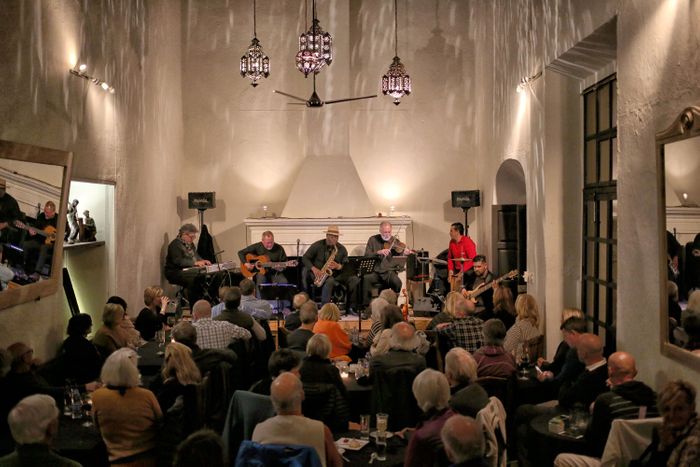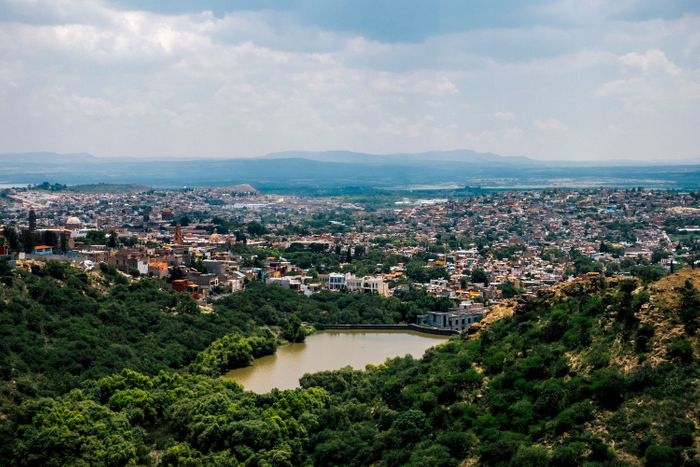
It’s commonly understood that the best way to explore a new place is to go straight to the locals. Each week in the Urbanist, we take that wisdom one step further by seeking out not just locals but local experts — those who are especially well versed in their cities’ newest and most noteworthy scenes — to give us insider recommendations. This week, we asked artist Sabina Arias, creator of the Malo artist residency, for her picks in the Mexican city.
“San Miguel de Allende has always been a magnet for artists from around the globe. It’s a unique place to visit because of its beautiful 18th-century Spanish architecture and its relevance in Mexican history. San Miguel was one of the most economically important towns during the Spanish rule and the cradle of the independence movement in 1810. Life here is very beautiful. The weather is really great. The houses are all yellow, red, and all these warm colors. It’s a very vibrant place. Near the Fabrica la Aurora art galleries, you can find the studios of extraordinary San Miguel artists such as Margaret Dawit and Gerardo Ruiz. And there are current efforts in San Miguel to revindicate its long-standing artistic legacy through many festivals, including the Guanajuato International Film Festival in July, the Chamber Music Festival in August, the Writers’ Conference and Literary Festival in January, and the Jazz Festival in November.”
Her Other Musts
Hotel
“If you are thinking about the downtown, I would recommend Posada Carmina (Cuna de Allende 7), which is located just by El Jardín. It’s in a historical building, a very old, 18th-century Colonial house, and run by a local family. The rooms are very spacious and have the typical San Miguel architecture: high ceilings with long wooden panels along them and floors made of mosaic clay. If you want to be in a more rural area, there is the magnificent Casa de Aves (Los Fresnos No. 1), an ecohotel that’s 20 minutes away from the center of San Miguel. It has ten gorgeous villas, large green gardens, and outdoor living rooms. It feels like a retreat. Everything in the hotel is so carefully put together. The rooms also have very high ceilings and thoughtful decoration, like handcrafted chairs and arts and crafts from different regions of Mexico.”
Art Galleries


“Galería Casa Diana (Recreo 48), which is owned by Pedro Friedeberg and has an incredible collection of his screen prints, drawings, paintings, and sculptures, is mandatory. Galería.Nudo (Recreo 10 B) is also a must. This gallery is careful in its curation and can feature anything from the work of Francisco Toledo, J. Clemente Orozco, and Demian Flores to some international artists. Another must-go-to place for the gallery lover is Fabrica La Aurora (Calz de La Aurora S/N). It used to be a textile factory and was turned into an art-and-design center in 2004. It has various shops that sell artisanal furniture, fine jewelry, textiles and clothing, antiques, mosaics, sculpture, ceramics, paintings, and other hand-picked and curated home décor. One of my favorite gallery spaces is Galeria Florencia Riestra, which was a famous gallery for three decades in Mexico City and relocated to San Miguel five years ago. They feature work by Juan Soriano, Jorge Marin, J.C. Orozco, and Tamayo.”
Markets
“Ignacio Ramírez Market (Calle Colegio, nr. Calle Homobono) is an authentic San Miguel experience. It has artisanal crafts from all over the country for a good price, literally everything you could imagine. Any time before 4 p.m. is good to visit. At the entrance of the market, you have the food vendors: If you want to have a smoothie or juices or prepared foods, you can go there. When you walk a little further in, you have all these farmers that come from surrounding areas to sell things. There are all these women that come for blue-corn tortillas, nopales, flor de calabaza, and other things that you wouldn’t necessarily know about if you’re not Mexican. The stalls don’t have names because there are so many of them and they’re so tiny. I really love this stand that sells these beautiful Oaxacan rugs. They’re made of lana, or wool, and there are all these geometric patterns that are very bright. Every single one is different. There’s another stall that has indigenious textiles from Chiapas, which are also amazing. You can buy a little hand-sewn bag or a satchel. These are great presents. Everybody loves them. My absolute favorite thing is handmade jewelry from the Wixáritari people. I give them to all my friends in Los Angeles. Wixáritari are indigenious peoples from the state of Nayarit. They have a tradition of making bracelets, necklaces, and earrings with imagery from their own mythologies, made with tiny very, very colorful plastic beads.”
Shops
“Because San Miguel is gentrifying, sometimes it’s difficult to find authentic places for shopping. The San Antonio neighbourhood is an interesting neighbourhood to visit. It is only a 15-minute walk from downtown. You have indigenous textiles at Juana Cata (Recreo 7) on Recreo street or a shop called Mixta (Pila Seca 3), which is Mexican-inspired modern fashion on Cuadrante Street. Sindashi (Calle del Dr. Ignacio Hernandez Macias 83) on Hernandez Macias Street has hand-painted dresses that are very sought out. Also the store La Calaca (Mesones 93) on Mesones Street has some high-quality textiles from Mexico and Guatemala.”
Breakfast


“People love to go out in the mornings and get breakfast in El Centro. My favorite place is Lavanda Café (Calle del Dr. Ignacio Hernandez Macias 78). It’s located a block from the main square, and they have the best coffee in town. The restaurant is small, but with a nice garden fountain in the middle and some greenery. My favorite dish is a huevos en cazuela, which is eggs baked in a clay pot with potatoes, tomatoes, and mushrooms, and my favorite coffee is the lavender almond latte or the almond flat white. You must arrive before 9:30 a.m. to avoid the queue. Inside Cafe (Insurgentes 66) is great because their breakfasts are very wholesome; they use a lot of seeds and grainy breads. I also like it because it’s owned by young artists and you can come here and read, do work on your computer, or enjoy the beautiful terrace view of the Biblioteca Publica.”
Restaurants
“Don Taco Tequila (Calle del Dr. Ignacio Hernandez Macias 83) used to be a restaurant selling meat tacos and traditional Mexican dishes, but a few years ago it turned vegan. Now it is one of the most popular restaurants in town, offering a sophisticated array of vegan Mexican dishes and some delicious cocktails. I like the cocktail called María Sabina, named after this famous healer from Oaxaca. It’s mezcal with hibiscus tea. My favorite dish is the esquites. I like to accompany that with their ceviche, which they make with seaweed and watermelon. It’s really really good and very citrusy. My favorite taco is the taco norteño, which has almond cheese and this very rich fungi called huitlacoche. Huitlacoche is kind of a delicacy. It’s basically a mushroom that grows on corn. It’s black and has a very sophisticated taste. In Mexico, it’s not very common to be a vegan, but it works because there are a lot of great vegetarian ingredients and products here. Another favorite is La Sirena Gorda (Calle del Dr. Ignacio Hernandez Macias 85), which offers fresh seafood dishes and live music on weekends. My favorite dishes are their amazing artichoke entrée with béchamel sauce, sashimi with tuna or salmon, and a fish version of tacos al pastor.”


“Rabeats bar (Ancha de San Antonio), just ten minutes walking from downtown, has a great selection of live music. It’s definitely an artists-magnet type of place. They play mostly funk and soul music and have a lot of different types of mezcal and tequila. Also Bistro Mi Casa (Ancha de San Antonio 20), owned by the renowned San Miguel musician Gil Gutierrez, features live music. More expats that go there, like older Americans who retire in San Miguel. It’s more formal because it’s a restaurant, but people go there for the music, too. Gamma (Calle Zacateros 73) is an LGBT bar owned by a local artist that attracts mostly locals in their 20s to 30s. It has a very cool loungey atmosphere, live DJ, and showcases different artists’ work on the walls, mostly in illustration, printmaking, and sculpture.”
Museums



“El Museo Histórico Casa de Allende (Cuna de Allende 1) showcases the history of the city and is worth a visit. The building is the birthplace and family home of Ignacio de Allende, whom the town is named after. He was a fighter for the Mexican independence movement. That’s why San Miguel is famous for being such a rebellious, independent town. They have all these artifacts from that time, like Mesoamerican figurines from the surrounding areas, paintings, and ceramics. Another one that is quite popular is Museo La Esquina (Núñez 40), which showcases Mexican toys and crafts from all the different regions and is quite beautiful.”
Attractions


“El Charco del Ingenio, or the Botanical Garden (Paloma S.N.), is my favorite place to be. It’s a space that’s very dedicated to the community. I’m sort of biased because my dad founded it and my parents have been a huge part of it. It’s been a very important place for different communities here in San Miguel, especially the indigenious communities who hold their ceremonies in the space throughout the year. La Parroquia (Principal S/N) is an iconic religious building, maybe one of the most photographed in Mexico, whose neo-Gothic façade, built in the beginning of the 20th century, has nothing to do with the Colonial architecture from the 18th century characteristic of the town’s historical center. Maybe a little bit overrated, but you will definitely walk past it 1,500 times if you visit San Miguel.”
Day Trips
“Only one hour and a half away from San Miguel, you can visit Guanajuato. The capital of the state, Guanajuato City is built on a narrow valley with little alleys and stairs that go along the mountainside surrounding its numerous plazas, churches, and Colonial buildings. The architecture and narrow streets are quite charming, and Guanajuato is also known for being an artist magnet: You can visit the Museo Casa Diego Rivera (Positos 47), Casa Museo Gene Byron (Marfil 10), and Museo Casa Olga Costa (Calle Pastita 158). Mineral de Pozos is a magic town located an hour away from San Miguel that was once a prominent mining site for silver. It’s surrounded by beautiful mountains and abandoned haciendas, including Hacienda Santa Brigida and Mina Cinco Señores. You can get to both by walking or by renting a four-wheeler in town and riding around the hillsides. Stop by Los Hornos del Mineral (Calle Ocampo 114) to get a taste of local delicacies, such as escamoles (ant larvae, a.k.a. Mexican caviar), or the main square to get colonche, a local drink made from fermented prickly pears. For music lovers, there are two Mesoamerican music shops, La Casa del Venado Azul (34 Calle Centenario) and Camino de Piedra (Calle Leandro Valle 13), where you can buy indigenous instruments, such as a wooden drum known as huehuetl, rain sticks, or stone marimbas.”
More Destinations
- The Urbanist’s Guide to Approachable, Unusual Hikes
- The Urbanist’s Guide to the Beaches of New Jersey
- The Urbanist’s Guide to Tucson




